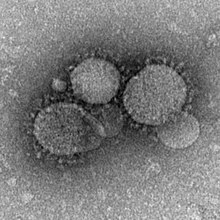MERS-CoV
| Koronavirus berkaitan sindrom pernafasan Timur Tengah | |
|---|---|

| |
| Zarah MERS-CoV seperti yang dilihat oleh mikroskop elektron noda negatif. Virion mengandungi ramalan-ramalan seperti kelab yang berpunca daripada membran virus. | |
| Pengelasan virus | |
| Templat taksonomi hilang (baiki): | Merbekovirus |
| Spesies: | Koronavirus berkaitan sindrom pernafasan Timur Tengah
|
Koronavirus berkaitan sindrom pernafasan Timur Tengah (MERS-CoV),[1] atau EMC/2012 (HCoV-EMC/2012), ialah spesies koronavirus yang menjangkiti manusia, kelawar, dan unta.[2] Virus yang menjangkiti ialah virus RNA yang terkandung, positif, yang memasuki sel perumah dengan mengikat kepada reseptor DPP4.[3] Spesies ini ialah ahli Betakoronavirus adan subgenus Merbekovirus.[4][5]
Pada mulanya dipanggil novel koronavirus 2012 (2012-nCoV) atau novel koronavirus (nCoV), ia mula dilaporkan 2012 selepas urutan genom virus diasingkan daripada sampel sputum daripada seseorang yang jatuh sakit akibat wabak selesema 2012 yang baru.
Setakat JulI 2015, kes MERS-CoV telah dilaporkan di 21 negara, termasuk Arab Saudi, Jordan, Qatar, Mesir, Emiriah Arab Bersatu, Kuwait, Turki, Oman, Algeria, Bangladesh, Indonesia (tiada satupun disahkan), Austria,[6] United Kingdom, Korea Selatan,[7][8] Amerika Syarikat,[9][10] Tanah Besar China,[11] Thailand,[12] dan Filipina.[13] MERS-CoV ialah salah satu daripada beberapa virus yang dikenalpasti oleh Pertubuhan Kesihatan Sedunia (WHO) sebagai kemungkinan penyebab wabak masa depan. Mereka menyenaraikannya untuk penyelidikan dan pembangunan yang mendesak.[14][15]
Rujukan[sunting | sunting sumber]
- ^ de Groot RJ, Baker SC, Baric RS, Brown CS, Drosten C, Enjuanes L, dll. (July 2013). "Middle East respiratory syndrome coronavirus (MERS-CoV): announcement of the Coronavirus Study Group". Journal of Virology. 87 (14): 7790–2. doi:10.1128/JVI.01244-13. PMC 3700179. PMID 23678167.
- ^ Wong, Antonio C. P.; Li, Xin; Lau, Susanna K. P.; Woo, Patrick C. Y. (2019-02-20). "Global Epidemiology of Bat Coronaviruses". Viruses. 11 (2): 174. doi:10.3390/v11020174. ISSN 1999-4915. PMC 6409556. PMID 30791586.
See Figure 3.
- ^ Fehr AR, Perlman S (2015). Maier HJ, Bickerton E, Britton P (penyunting). "Coronaviruses: an overview of their replication and pathogenesis". Methods in Molecular Biology. Springer. 1282: 1–23. doi:10.1007/978-1-4939-2438-7_1. ISBN 978-1-4939-2438-7. PMC 4369385. PMID 25720466.
See Table 1.
- ^ "Virus Taxonomy: 2018 Release". International Committee on Taxonomy of Viruses (ICTV) (dalam bahasa Inggeris). October 2018. Dicapai pada 13 January 2019.
- ^ Wong, Antonio C. P.; Li, Xin; Lau, Susanna K. P.; Woo, Patrick C. Y. (2019-02-20). "Global Epidemiology of Bat Coronaviruses". Viruses. 11 (2): 174. doi:10.3390/v11020174. ISSN 1999-4915. PMC 6409556. PMID 30791586.
See Figure 1.
- ^ "Disease Outbreak News". www.who.int. 8 Oct 2014.
- ^ "Middle East respiratory syndrome coronavirus (MERS-CoV) – Republic of Korea". www.who.int. 24 May 2015.
- ^ Jack A (June 2015). "Why the panic? South Korea's MERS response questioned". BMJ. 350: h3403. doi:10.1136/bmj.h3403. PMID 26108610.
- ^ Roos, Robert (16 Jun 2014). "Bangladesh has first MERS case". cidrap.umn.edu. Unknown parameter
|name-list-format=ignored (bantuan) - ^ "Florida MERS patient recovers". CNN.
- ^ "Middle East respiratory syndrome coronavirus (MERS-CoV) – China". 31 May 2015.
- ^ "Thailand confirms first Mers case: Health ministry". 18 June 2015.
- ^ "Philippines Confirms First Case of MERS". TIME. 6 July 2015. Diarkibkan daripada yang asal pada 2015-07-10. Dicapai pada 2020-03-17.
- ^ Kieny, Marie-Paule. "After Ebola, a Blueprint Emerges to Jump-Start R&D". Scientific American Blog Network. Dicapai pada 13 December 2016.
- ^ "LIST OF PATHOGENS". World Health Organization. Diarkibkan daripada yang asal pada 2016-12-20. Dicapai pada 13 December 2016.
Pautan luar[sunting | sunting sumber]
| Wikimedia Commons mempunyai media berkaitan MERS-CoV |
| Wikispesies mempunyai maklumat berkaitan dengan MERS-CoV |
